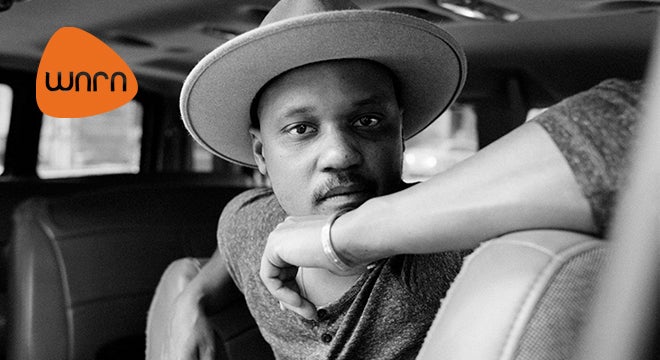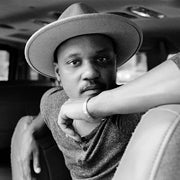
WNRN presents Son Little
WNRN presents Son Little
with Doe Paoro
About Son Little:
What is the new magic of music? If you trace the path of a plan back to its beginnings, what do you find? Is it a tree, growing from seed with deep roots planted in fertile soil, branches arcing out in all directions? Or a spark in the dark, an electrical charge? Is it a waterway, with swirling currents raging to create a river? Or is it a snowflake, falling from on high and dropping down to earth with a singular splash?
For Son Little, the genesis of a musical idea — the magic — remains largely a mystery. But his kinetic ability to summon that energy all the same, to command it, hold onto it, and set it in motion, is the stuff of alchemy.
“The magic is this well I can draw from; you can’t necessarily see it, you just have to believe that it’s there,” he says. “If you believe, then you can reach your hand down in there and get it wet. But if you don’t feel like it’s there, it won’t be.”
Son Little, the singer and songwriter born Aaron Livingston, is the easygoing musical alchemist of our time. He is a conjurer, and much like those of his heroes Stevie Wonder and Jimi Hendrix, his songs are deconstructions of the diaspora of American R & B. Deftly he weaves different eras of the sound — blues, soul, gospel, rock and roll — through his own unique vision, never forced, always smooth, each note a tributary on the flowing river of rhythm and blues. The currents empty into an estuary, and into this well water Son dips his bucket — trusting innately in the magic’s existence. And now, with his second full-length album, New Magic, he has delivered a profound statement, a cohesive creation that captures the diverse spirit of American music in a fresh and modern way.
On the heels of his 2015 self-titled debut and the 5-song EP, Songs I Forgot, that came before it, Son Little found his reach steadily growing. His song “Lay Down” had been played over seven million times on Spotify, he had toured the world with artists as diverse as Leon Bridges, Kelis, Mumford & Sons, and Shakey Graves in addition to his own headlining runs, and also became a Grammy Award winning producer, earning a 2016 Best Roots Performance award for his work on Mavis Staples’s “See That My Grave Is Kept Clean.” But in the midst of all this success, so too did he find that the window for writing new songs was shrinking. Where his previous releases had been culled from various eras and scattered sessions early in his career, he now craved an opportunity to sit and write a new album in a distinct, unified direction, one that would establish his place in the world of black music. The only problems were: when, and how?
“I was on the road so much and found myself wanting to write, but I couldn’t really find time or space to do it in the way I wanted,” Son Little says. “I was playing around with beats or messing with chord changes; I had all these little fragments, thinking I would later piece them together. I kept the wheels turning by doing those exercises, but I knew it would feel really luxurious to be able to sit down by myself and write something from scratch. I was really hungry to get in that space and chisel out something new, without being interrupted by sound checks and rides in vans and radio. All that stuff is cool and I was having a blast touring, but a crucial part for me was missing. I wanted the writing to be broken up as little as possible.”
In the meantime, all that motion was filling him with both confidence and inspiration for the next step. The limitations he encountered while performing a debut record with so much studio sorcery via a live band onstage each night were influential in terms of how he began thinking about a followup. “I’ve often been a guy who was somewhat hiding behind the guitar,” he says. “Getting used to being out front and exposing the guitar and my voice, and leaving a lot of space in the material, all really inspired me and got the wheels turning for what I would do with the next group of songs.”
Sometimes, in order to see the stars, you have to get far away from the city lights. Finally, in the fall of last year, Son Little found himself in such a place, and it was there at the end of a tour in the remote, tropical Northern Territory of Australia that he looked up in the sky and saw the perfect alignment. Benefitting from several hours free on a string of consecutive days as well as the excitement of alien terrain and the inherent magic in a borrowed instrument, he felt things starting to come together.
“The Northern Territory is a place where things are moving a little slower than anywhere else,” he says. “There were these big crocodiles and enormous bats, just wild things I’d never seen. I found myself with a few hours to kill a couple days in a row, and I set up in the hotel and just kinda followed the process: I found a rhythmic idea I liked and then sang and played a little guitar over it. Like a tip jar in a cafe that fills up after the first dollar goes in, you need that first little piece to slide into place and then the whole thing comes together. I ran off five songs all in the same day.” (Three of those songs, “Kimberly’s Mine,” Charging Bull,” and “Mad About You,” would make the album.)
That process to which he refers stems from an experience he encountered while writing a cornerstone of his early material, the soul-scorching, chanty-like “Your Love Will Blow Me Away When My Heart Aches,” one of few moments of inspiration he can still visualize. The song came to him while standing in his bedroom; beginning with a couple of words and a tempo, Son Little started to pound his fist on the dresser and made up the song’s melody on the spot. “I was banging on the dresser, and then I don’t know what happened. There was no melody, no words...and now there is. I know now that if I get part of the melody, a phrase or two, and a tempo, then the rest will follow. So I wanted to follow that pattern for the new songs and let the idea grow from that without worrying about what the production would sound like or which guitar to use. I was more focused on finding the song and the arrangement.”
But, as it happened, the guitar seemed to find him, too. “All those songs in Australia were written with one mic and an acoustic left-handed guitar I was playing upside-down,” he says. “It was borrowed from the Australian singer Gurrumul, a blind Aboriginal musician with this angelic voice. I needed a guitar and he was nice enough to loan it to me; I took it upstairs and all those songs came out of it. You hear people say guitars have songs in them, and that one certainly did.
Whether or not Son Little was aware at the time of the overt connection to his pair of R & B heroes — Stevie and Jimi — that lending presented is unclear. Let’s, again, chalk it up to the magic.
“Those two dudes are a little bit alone there; I can’t see how there can be a higher level of musical genius after Stevie and Jimi,” he says. “I do think of both of them as R & B guys, but neither was trying to contain themselves there in any way. They were letting themselves be influenced by other stuff, be it jazz or Latin music or whatever, but they were just making songs and musically doing what felt good. That’s what I wanted to do here. I do see myself that way, in the branches of the R & B river.”
(A quick but magical aside: In the winter of 2015, Son found himself invited to a reading a friend was giving at Electric Lady Studios in New York City, the legendary underground recording facility conceived and once owned by Jimi Hendrix himself. After the event he was invited to spin his debut album on the studio’s speakers, and while it played an employee asked him if he would like to “see the river” — a trickling branch of the seldom seen Minetta Creek that runs under parts of Manhattan. “I put my record on — which was a trip, like I was playing it for Jimi — and we went back in the corner behind where the amps are set up, and they pulled this panel up, and sure enough, there’s running water right under the floor. You can stick your hand in there and get it wet.”)
Flowing water is a recurring theme in Son Little’s music, in addition to its symbolic inspiration. From his debut’s hit “The River” to a lyric in “Mad About You” (“Now you say it’s different, baby/ After I took you to the river”), his work tends to be thematically waterlogged. “My well is fed by the different tributaries, the other water sources that pour into it,” he says. “When you dip your bucket into it, you’re gonna get all kinds of different water. Water behaves that way underground, too; you can dig if you know where it’s at, and there are people, like the Aboriginal water diviner, who can find the water. My music has a kind of magic in it, being connected to whatever those forces are.”
Having been handed the divining rod in Australia, Son Little was able to connect the dots and finish New Magic by early spring. The trio written Down Under form the heart of the album’s vibe, with “Kimberly’s Mine” leading the record off with its Old Blues soap-operatic feel, and “Charging Bull”’s funky, fevered groove and the D’Angelo-inspired R & B minimalism of “Mad About You” — a lovelorn, aching track Son Little claims found itself only when he stripped it down to its barest essentials — holding anchor in the middle. But the song that serves as the album’s true centerpiece is “Blue Magic,” a Philly Soul inspired number deconstructed almost like a rap song or the best of production savants like J Dilla, Madlib, and Sparklehorse’s Mark Linkous, complete with chiming glockenspiel bells and old school female backing vocals. With its origins predating the Australia trip, the song has the appeal of an instant classic, a feeling that did not escape its maker, either.
“I knew ‘Blue Magic’ would be my focal point from the second I made it up,” Son Little says. “I was just goofing around before a show — and I wish I could explain where something like this comes from but I have absolutely no idea — and I was freestyling with the guitar. The thought occurred to me that people were characterizing my music as this new blues thing, even though I was never exactly trying to heroically ‘save the blues’ or anything like that, or even put myself in a place where everything had to be bluesy. But suddenly I’m telling you in the song I’ve got the ‘blue magic,’ and even though there are things called ‘blue magic’ I hadn’t seen that phrase anywhere or heard anyone say it. But I said it, and then there’s a pressure to back it up, to support that claim. I think I’m addicted to that pressure; this thing is hanging in the balance, and the whole thing can go up in smoke if I don’t figure this out and put these pieces together in motion. I enjoy the feeling of not knowing what’s gonna happen from there; it doesn’t always end perfectly but I think you have to resolve that pressure, and not knowing how is really exciting to me. That feeling is somewhat hanging over this whole album: watch me make something out of thin air.”
Following that lead are the pair of “Bread and Butter,” a playful, modern take on James Brown, and “The Middle,” a classic drinking-blues, both deconstructed through a filter of musical Cubism. “ASAP” is Son Little’s fiery, direct take on a Hendrix rock and roll song, and “Letter Bound” reminds of a yearning, crooning Bobby Womack joint, with the “little cry” in Son Little’s voice, as Mavis Staples calls it, taking the spotlight. The album ends with the ethereal, gospel-tinged number “Demon to the Dark,” which serves as the singer’s conversation with Washington Phillips, a little known blind musician and church deacon from early in the 20th century whose song “What Are They Doing in Heaven Today” utilized the dulceola, a novelty instrument comprised of two autoharps essentially stuck together. Phillips was a man of strong faith, a deacon in his church, and in his music Son Little found a source of forgiveness as well as an inspiration to carry on. As chiming strains of Omnichord take us out, the electricity in the air is palpable, the belief and trust in the spark at its peak.
What is the new magic? How did that deep well get there in the first place, and what is the source water of all these confluents pouring in? To Son Little, there is an attitude running through his makings and his music, a mighty river of superstition and Spanish castles that runneth over. And despite its murky and mysterious origins, the musician’s divination ability is just that — divine.
“There is this vein of the blues in it, and it can be distilled or boiled down just to the guitar and voice — or even just the voice,” he says. “And that process of me in my bedroom, making ‘Your Love’ with the dresser as the drum — I did that same thing as I wrote these songs. It’s that same scenario of making something out of nothing. And even if I am capable of doing that, I can’t really explain it. That’s the gist of the magic. I don’t know where it comes from, but it’s there, and I can call on it. I can call on it standing by the dresser, walking down the street, driving a car, on a train, a plane, in a hotel room, in the green room, during an interview...it’s just there. I’m trying to pay tribute to that fact. It’s had a really powerful and in some ways increasingly healing effect on my life. Hopefully other people have that experience with it as well. I’m just happy that it’s there, wherever it comes from.”
“The best of what humans and machines can bring out in each other” is how NPR Music described Doe Paoro’s single “The Wind,” a meditation on urban isolation in the face of Hurricane Sandy. The song, which was produced by Bon Iver’s Justin Vernon with beats by Chicago duo Supreme Cuts, sets the tone for the upcoming release of Paoro’s Anti- debut album, After, out on September 25.
The album’s first single is the intoxicatingly downtempo, R&B-influenced “Growth/Decay,” which Paoro co-wrote with Sterling Fox (who has previously worked with Lana Del Rey, among others). The groove-laced, gospel-inspired track ruminates on the notion that change fuels all life, with the chorus putting out the call to “cycle to the light or fade away.”
For After, Paoro worked with producers Sean Carey (drummer / supporting vocalist for Bon Iver) and BJ Burton (The Tallest Man on Earth, Sylvan Esso, and others) to even further deepen her musical repertoire, creating a mesmerizing hybrid of R&B, synthpop, and indie-leaning electro rooted in an earthy minimalism, drawing from influences ranging from Carole King to Portishead, Aretha Franklin and beyond. The album was recorded at April Base, a Wisconsin ranch house that Vernon had converted into a studio. “I’m used to just working with a piano,” says Paoro, “but with this album, we built an entire world with the sonics alone.”
Read More
Design VisualSHOWINGS
This event has already occurred.
The Southern
-
Thu, May 1, 2025
Maya de Vitry (TRIO)
-
Fri, May 2, 2025
Short n’ Sweet: A Sabrina Carpenter Drag & Dance Party (16+)
-
Sat, May 3, 2025
No Stupid Questions
-
Sun, May 4, 2025
Songwriter Showcase Hosted by Theocles Herrin








